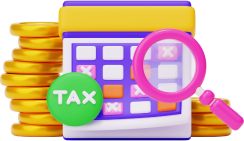-
Visas & Immigration
-
Taxes
-
Cost of Living
-
Companies Hiring
-
Relocation Companies
-
Jobs
-
Salaries
-
Healthcare & Insurance
-
Webinars
Taxes in Canada

Lais Cattassini
Lais is a Brazilian journalist and copywriter with over 17 years of experience, writing about things she knows really well (travelling, cinema, social media trends) and things she loves learning about.

Oleksandra Dosii
Oleksandra is a dedicated marketer with a passion for growing HR-tech products. She believes content marketing is about delivering high-quality content that provides value—not just generating leads. Since 2016, Oleksandra has been involved in tech talent relocation.

Start Advertising

Canada's tax system is administered primarily by the Canada Revenue Agency (CRA) and involves several levels of taxation, including federal, provincial/territorial, and local taxes.
All Canadian residents are subject to federal income tax on their worldwide income. The tax system is progressive, meaning higher income levels are taxed at higher rates. For individuals, federal tax rates range from 15% to 33%. Each province and territory also has its own income tax rates, which are applied in addition to federal taxes. These rates also vary by income level, creating a combined tax rate.
Corporations in Canada pay tax on their net income (profits). The general corporate tax rate is 15% federally, with small businesses benefiting from a reduced rate (around 9%). In addition to federal taxes, corporations also pay provincial/territorial corporate taxes, which vary by jurisdiction and industry.
Both employers and employees contribute to social security programs with the Canada Pension Plan (CPP) and the Employment Insurance (EI).
Most provinces have agreements with the federal government to collect their income taxes on their behalf. In return, the federal government shares some of its revenues with provinces and territories to support healthcare, education, and infrastructure.
Quebec operates its own income tax system and has its own tax collection agency, the Revenu Québec. This means that Quebec residents must file two separate tax returns (federal and provincial).
The Canada Revenue Agency (CRA) is responsible for ensuring compliance with tax laws. This involves processing tax returns, conducting audits, and investigating cases of tax evasion or fraud. The CRA has significant powers to enforce tax collection, including garnishing wages, seizing assets, and applying penalties for non-compliance.
What is the income tax in Canada?
In Canada, income tax is one of the primary sources of government revenue and is levied on individuals and businesses at both the federal and provincial/territorial levels.
Income is taxed in brackets, with different portions of income being taxed at different rates:
| Taxable income | Tax rate |
| Up to $55,867 | 15% |
| $55,867 to $111,733 | 20.5% |
| $111,733 to $173,205 | 26% |
| $173,205 to $246,752 | 29% |
| Over $246,752 | 33% |
Provincial and territorial income tax
Each of Canada's provinces and territories has its own income tax rates, which are applied in addition to the federal rates. These rates also follow a progressive structure and vary from one region to another.
Ontario, for example, imposes rates ranging from 5.05% to 13.16%. Quebec, which has a separate tax system, has rates ranging from 14% to 25.75%. You can see the complete list of rates per province here.
When combined, these provincial rates create a combined federal-provincial rate that differs by region.
Social Security contributions
The two main social security programs requiring mandatory contributions in Canada are the Canada Pension Plan (CPP) – or Quebec Pension Plan (QPP) for Quebec residents – and Employment Insurance (EI).
The CPP is a mandatory public pension plan for workers in Canada, except for Quebec, which operates its own version known as the QPP. Both programs aim to provide retirement income, survivor benefits, and disability benefits. Contributions are made by both employers and employees, and self-employed individuals pay both portions.
Both employers and employees contribute 5.7% of an employee’s earnings (up to the Year’s Maximum Pensionable Earnings (YMPE), which is CAD 64,900. Self-employed individuals pay the full amount, i.e., 11.4%.
In Quebec, the contribution rate for the QPP is slightly higher than that of the CPP due to differences in program costs. For 2024, it is 5.4% for both employees and employers (12.80% for self-employed individuals), with the YMPE being CAD 68,500.
Employment Insurance (EI) is a program designed to provide temporary financial support to individuals who are unemployed through no fault of their own, as well as to those on maternity, parental, sickness, and caregiver leave. Both employers and employees contribute to the EI program.
Employers deduct EI premiums from employees' paychecks, and they also contribute a matching or higher amount. Self-employed individuals can opt into the EI program for maternity and parental benefits, but they generally cannot receive regular EI benefits for unemployment unless they’ve opted into a special EI agreement.
For residents outside Quebec, the contribution rate is 1.66% of insurable earnings up to the Year’s Maximum Insurable Earnings (YMIE) of CAD 63,200. In Quebec, the employee rate is 0.49% due to the province's separate parental insurance plan (QPIP).
Online tax calculator for taxes in Canada
Calculating income tax in Canada involves understanding the progressive tax system and both the federal and provincial/territorial income taxes. Deductions and credits can reduce the amount of tax owed.
The Canadian government provides a tool to calculate the amount of taxes you pay, and you can calculate your net income here.
Annual tax returns in Canada
Most individuals who earn income in Canada need to file a tax return every year. You can either file one online, use a tax preparer, or mail a paper return. Most Canadians now file electronically using NETFILE, a CRA-certified online filing service.
When filing your taxes, you will need to complete the T1 General Form, informing your total income, subtraction deductions, applying federal and provincial taxes and subtracting credits. Once complete, submit your return electronically or by mail.
The tax year in Canada follows the calendar year, beginning on January 1 and ending on December 31. The deadline to file a tax return is April 30 of the following year. If you are self-employed, the filing deadline is extended to June 15, but any taxes owed must still be paid by April 30 to avoid interest charges.
Once you file your return, the CRA processes it and determines whether you owe taxes or if you are owed a refund. The CRA typically processes refunds within two weeks if you file online or eight weeks if you file by paper. You can receive your refund by direct deposit or by mail (cheque).
If you owe taxes but cannot pay the full amount by the deadline, the CRA may offer payment arrangements if you communicate with them and agree on a schedule to pay off the balance.
How to pay less taxes
One of the most effective ways to lower your taxable income is by contributing to tax-advantaged accounts. These accounts allow you to defer or reduce taxes, either now or in the future. You can also enjoy deductions.
Registered Retirement Savings Plan (RRSP)
Contributions to an RRSP are tax-deductible, meaning they reduce your taxable income for the year. Your investments grow tax-free until you withdraw them, typically in retirement when you may be in a lower tax bracket.
Tax-Free Savings Account (TFSA)
While contributions to a TFSA are not tax-deductible, all investment growth, interest, dividends, and withdrawals are tax-free. This can be particularly beneficial for tax-efficient long-term growth.
Home office expenses deductions
If you work from home, you can claim a deduction for expenses related to maintaining your home office. You must use the workspace regularly and exclusively for employment purposes.
You can deduct expenses such as utilities (heat, electricity), internet, rent (if you’re a renter), maintenance, and a portion of home insurance and property taxes (for commission-based employees).
Vehicle expenses deductions
If your job requires you to use your vehicle for work purposes, you may be able to deduct expenses such as gas, maintenance, insurance, depreciation (capital cost allowance), and lease payments (if leased).
Child care expenses
You can claim a deduction for childcare expenses incurred to allow you or your spouse to work, attend school, or conduct research.
Spousal and dependent credits
If your spouse or common-law partner has low or no income, you can claim the spousal amount. You can also claim credit for dependent relatives, such as elderly parents.
Charitable donation credits
Donating to registered charities not only supports a cause you care about but also provides a tax benefit.
Medical expense deductions
Medical expenses not covered by insurance can be deducted if they exceed 3% of your net income or CAD 2,479 (whichever is less) in a year.
Talk to a tax advisor
Consult a tax advisor or accountant to ensure you pay taxes correctly and collect benefits, allowances, and deductions. For expats, services like these can be extremely beneficial, as they help foreigners overcome language barriers and the complicated tax regulations of a new country.
Other taxes in Canada
In Canada, taxpayers are subject to various taxes beyond income taxes. These taxes are designed to fund public services and infrastructure at the federal, provincial/territorial, and municipal levels.
Goods and Services tax (GST) / Harmonized Sales tax (HST)
GST is a federal tax of 5% applied to the sale of most goods and services in Canada. HST is a combination of GST and provincial sales tax (PST) in certain provinces. The HST rate varies by province and includes both the 5% GST and the provincial portion.
These taxes apply to most goods and services, including groceries (in some cases), utilities, and consumer products.
Property tax
Property taxes are levied by municipal governments and are based on the assessed value of the property you own (be it residential, commercial, or industrial). Rates vary widely depending on the municipality and property type.
Carbon tax
The carbon tax is a federal or provincial levy applied to the purchase of fossil fuels, including gasoline, diesel, natural gas, and propane, to reduce greenhouse gas emissions. Rates vary by province, but is embedded in the price of goods and services.
Land Transfer tax
Land transfer tax (also known as property transfer tax) is a provincial or municipal tax applied when real estate is purchased. The rate and application vary by province.
Capital Gains tax
According to the Canadian government, you have a capital gain when you sell assets for more than the total of its adjusted cost. Capital gains of over $250,000 annually are taxable at a 66% tax rate.
Luxury tax
Introduced by the federal government, the luxury tax applies to high-value goods like cars, boats, and aircraft.
Tax treaties with Canada
Canada currently has tax treaties with 96 countries aimed at avoiding double taxation and encouraging investments. Here is the complete list of countries that have agreements with Canada.
Need to consult a tax advisor or an accountant?

Fill out this form

Shoot us an email with your inquiry at [email protected].




















